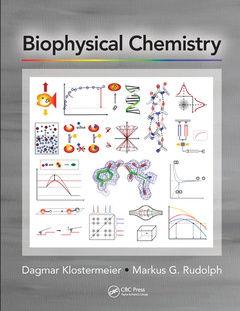Biophysical Chemistry

Biophysical Chemistry explores the concepts of physical chemistry and molecular structure that underlie biochemical processes. Ideally suited for undergradate students and scientists with backgrounds in physics, chemistry or biology, it is also equally accessible to students and scientists in related fields as the book concisely describes the fundamental aspects of biophysical chemistry, and puts them into a biochemical context.
The book is organized in four parts, covering thermodynamics, kinetics, molecular structure and stability, and biophysical methods. Cross-references within and between these parts emphasize common themes and highlight recurrent principles. End of chapter problems illustrate the main points explored and their relevance for biochemistry, enabling students to apply their knowledge and to transfer it to laboratory projects.
Features:
- Connects principles of physical chemistry to biochemistry
- Emphasizes the role of organic reactions as tools for modification and manipulation of biomolecules
- Includes a comprehensive section on the theory of modern biophysical methods and their applications
Thermodynamics. Systems and their surroundings. State functions and the laws of thermodynamics. Energetics and chemical equilibria. Thermodynamics of transport processes. Electrochemistry. Kinetics. Reaction velocities and rate laws. Integrated rate laws for uni and biomolecular reactions. Reaction types. Rate-limiting steps. Binding reactions: one-step and two-step binding. Steady-state (enzyme) kinetics. Complex reaction schemes and their analysis. Temperature dependence of rate constants. Principles of catalysis. Molecular structure and stability. Molecular structure and interactions. Proteins. Nucleic acids. Computational biology. Optical spectroscopy. Magnetic resonance. Solution scattering. X-ray crystallography. Imaging and microscopy. Force measurements. Transient kinetic methods. Molecular mass, size, and shape. Calorimetry. Prefixes, units, constants. Mathematical concepts used in this book.
Dagmar Klostermeier is of the University of Muenster, Germany.
Markus G. Rudolph is of the Pharma Research & Early Development Division in the Roche Group, Switzerland.
Date de parution : 06-2020
21.6x28 cm
Date de parution : 02-2018
21.6x27.9 cm
Thèmes de Biophysical Chemistry :
Mots-clés :
ATP Dependent Reaction; ADP State; ATP Hydrolysis; Derived Rate Laws; Net Rate Constants; ATP Synthesis; EAB Complex; Integrated Rate Laws; Electric Potential; Electromotive Force; kJ Mol; Kinetic Isotope Effect; Holliday Junction; Reaction Velocity; Equilibrium Dissociation Constant; Thermodynamic Linkage; Individual Rate Constants; Transition State Theory; Total Enzyme Concentration; Acceptor Fluorescence; Fret Efficiency; Secondary Structure Elements; Single Molecule Fret; Force Extension Curves; Magnetic Tweezers



